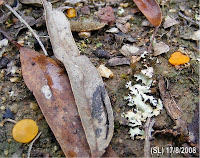In this photo, the black square thing you can see (extreme right) is the plant tube tunnel leading to the nest.
There has been a huge amount of food ferried into the nest but I've been unable to grab a photo because the birds are far too quick! I've seen black things which might be caterpillars or millepedes going in.
At the moment, one adult remains with the young until the other returns. There is a quick exchange of Pardalote dialogue and the guard is then changed! :-)
This photo shows one parent ready for the other to arrive as it did a second or two later after this photo was taken.
(Click images to enlarge)

I hope the chicks make it to adulthood and I will keep you posted as to their progress.
By the way, I couldn't find the egg shells anywhere. These ones must have seen them off a fair distance from the nest. The Pardalotes that nested in my stable just dumped the shells on the floor beneath the nest.
__________________________________________
Memo to Denis ;-)
LepSIO has this premises under surveillance!

OK for those who don't know what I'm talking about, this is the Willie Wagtail nest in my Melaleuca. I would not have known the nest was there had I not seen a Wagtail picking up some nesting material from the lawn and then go straight to the nest. It is so well camouflaged on a branch high up in the tree. So far, the hen has still not begun to brood.
The reason LepSIO (me) is alert but not alarmed is because one of the Waggies whacked a butterfly I was observing who was looking to lay its eggs in some Mistletoe growing in the Melaleuca! :-)






















































